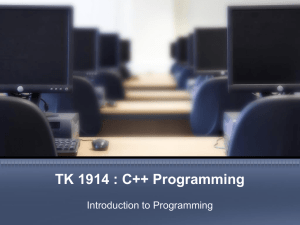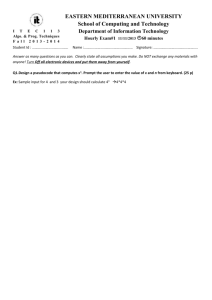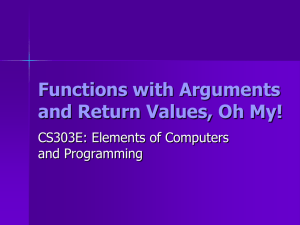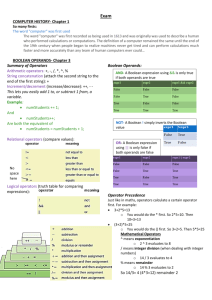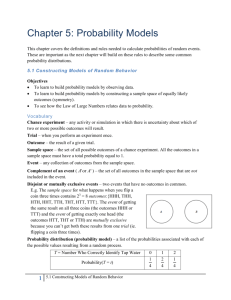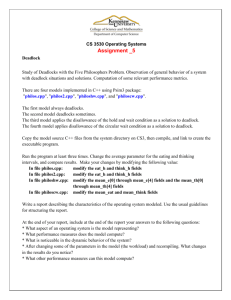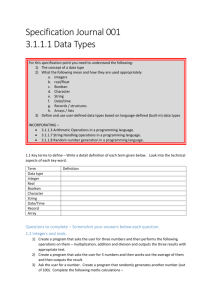if - FTSM
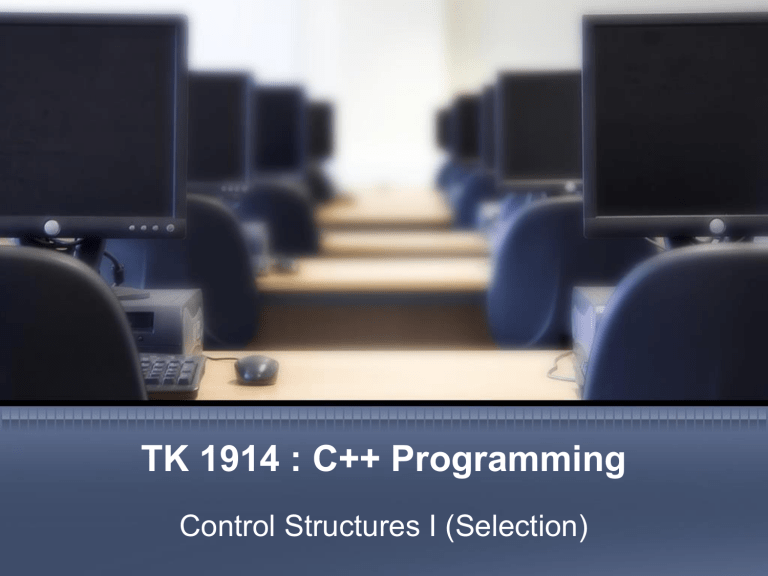
TK 1914 : C++ Programming
Control Structures I (Selection)
OBJECTIVES
In this chapter you will:
• Learn about control structures
• Examine relational and logical operators
• Explore how to form and evaluate logical
(Boolean) expressions
• Discover how to use the selection control structures if , if ...
else , and switch in a program
FTSM :: TK1914, 20112012 2
INTRODUCTION
• A computer can process:
– In sequence
– Selectively (branch) - making a choice
– Repetitively (iteratively) - looping
• Some statements are executed only if certain conditions are met
• A condition is represented by a logical (Boolean) expression that can be true or false
• A condition is met if it evaluates to true
FTSM :: TK1914, 20112012 3
FTSM :: TK1914, 20112012 4
• We have seen sequencing in C++.
• How do we translate selection and repetition structures into C++?
FTSM :: TK1914, 20112012 5
SELECTION STRUCTURES IN C++
• Selection structures can be translated into C++ using if statements.
• Four forms of selection structures will be looked at:
– One-Way
– Two-Way
– Nested
– Switch
FTSM :: TK1914, 20112012 6
if STATEMENT :
ONE-WAY SELECTION
• The syntax of one-way selection is: if (expression) statement
• statement expression is executed only if the value of is true
• expression is usually a logical expression.
• if is a reserved word
• statement must be a single C++ statement.
FTSM :: TK1914, 20112012 7
if STATEMENT :
ONE-WAY SELECTION
FTSM :: TK1914, 20112012 8
FTSM :: TK1914, 20112012 9
CLASS ACTIVITY 3.1
• Refer prog03.1.cpp
.
– Examine the source code. Focus on the if statements.
– What do you think the output would be for the following input?
• Price per unit: RM25 Quantity: 4
• Price per unit: RM5.50 Quantity: 5
– Run the program with the above input. Is the output generated the same as expected?
– Draw a flowchart representing the algorithm implemented in the program.
FTSM :: TK1914, 20112012 10
if-else STATEMENT: TWO-
WAY SELECTION
• Two-way selection takes the form: if (expression) statement1 else statement2
• If expression is true , statement1 is executed.
Otherwise, statement2 is executed
• else is a reserved word
• statement1 and statement2 must both be single C++ statements.
FTSM :: TK1914, 20112012 11
if-else STATEMENT: TWO-
WAY SELECTION
FTSM :: TK1914, 20112012 12
FTSM :: TK1914, 20112012 13
CLASS ACTIVITY 3.2
• Refer prog03.2.cpp
.
– Examine the source code. Focus on the if statements.
– What do you think the output would be for the following input?
• Number of adults: 2 Number of children: 2
Ticket type: First class
• Number of adults: 2 Number of children: 2
Ticket type: Economy
– Run the program with the above input. Is the output generated the same as expected?
– Draw a flowchart representing the algorithm implemented in the program.
FTSM :: TK1914, 20112012 14
CLASS ACTIVITY 3.2
• Observe that prog03.2.cpp
includes the following declarations: const float PRICE_FIRST_CLASS = 30.00; const float PRICE_ECONOMY = 5.00;
The identifiers PRICE_FIRST_CLASS and
PRICE_ECONOMY are called constants. Their values cannot be changed during program execution.
FTSM :: TK1914, 20112012 15
COMPOUND STATEMENTS
• Consider the following structure: input num num = 0?
false true print warning num ← 10 result ← sum / num
FTSM :: TK1914, 20112012 16
COMPOUND STATEMENTS
• Note that there are two statements to be executed if num is equal to 0.
• Is it correct to translate the above to C++ as follows?
cin >> num; if (num == 0) cout << "Invalid value!"; num = 10; result = sum / num;
• Answer: No. According to C++ syntax, the statement num = 10; is actually not part of the if statement .
FTSM :: TK1914, 20112012 17
COMPOUND STATEMENTS
• In this case, we need to use a compound statement to group those statements into a single statement.
• A compound statement is simply a set of single statements enclosed within curly brackets.
{ statement_1;
… statement_n;
}
• Remember that a compound statement is a single
C++ statement.
FTSM :: TK1914, 20112012 18
• Example: cin >> num; if (num == 0)
{ cout << "Invalid value!"; num = 10;
} result = sum / num; compound statement
FTSM :: TK1914, 20112012 19
NESTED IF
• Consider the syntax of a one-way if statement: if (expression) statement
• You might ask: Could statement be another if statement?
Example: if (weight > 100) if (weight <= 1000) price = 0.20 * weight;
What does it mean?
FTSM :: TK1914, 20112012 20
NESTED IF
• Example:
FTSM :: TK1914, 20112012 21
NESTED IF
• Can also be written as follows (remember that the compiler ignores unnecessary whitespace characters):
FTSM :: TK1914, 20112012 22
CLASS ACTIVITY 3.3
• Examine the following code:
How is this code different from that in the next slide?
FTSM :: TK1914, 20112012 23
FTSM :: TK1914, 20112012 24
CLASS ACTIVITY 3.4
• The following bands are defined:
– Band 1: 75 and above
– Band 2: 51 - 74
– Band 3: 50 and below
• Refer prog03.3a.cpp
.
– Examine the source code. Focus on the if statements.
– What do you think the output would be for the following input?
• 80
• 60
• 40
– Run the program with the above input. Is the output generated as expected?
FTSM :: TK1914, 20112012 25
CLASS ACTIVITY 3.4 (CONT)
• Refer prog03.3b.cpp
.
– Examine the source code. How is it different from the previous program?
– What do you think the output would be for the following input?
• 80
• 60
• 40
– Run the program with the above input. Is the output generated as expected?
– Draw a flowchart representing the algorithm implemented in the program.
FTSM :: TK1914, 20112012 26
CLASS ACTIVITY 3.4 (CONT)
• Refer prog03.3c.cpp
.
– Examine the source code. How is it different from the first program?
– What do you think the output would be for the following input?
• 80
• 60
• 40
– Run the program with the above input. Compare the output with that of the previous program.
– Draw a flowchart representing the algorithm implemented in the program.
• C++ always associates an else with the closest unpaired if .
FTSM :: TK1914, 20112012 27
switch STRUCTURE
• switch structure: alternate to if-else .
• Example:
Execute the statements inside the switch structure starting from the case which matches the value of the expression switch (code) { case 1: cout << "one"; case 2:
First, evaluate the switch expression cout << "two"; default : cout << "Error";
}
If there is no match, start from the default case
FTSM :: TK1914, 20112012 28
CLASS ACTIVITY 3.5
• Refer prog03.4.cpp
.
– Examine the source code. Focus on the switch statement.
– Observe that there are return statements in the switch statement.
• What do you think will happen if they are executed?
• Why do you think they are there for?
– What do you think the output would be for the following input?
• 2 adults, 2 children, normal first-class ticket
• 2 adults, 2 children, economy ticket
FTSM :: TK1914, 20112012 29
CLASS ACTIVITY 3.5 (CONT)
• Refer prog03.4.cpp
.
– Run the program with the input data given above. Is the output as expected? Explain.
– Draw a flowchart representing the algorithm implemented in the program.
FTSM :: TK1914, 20112012 30
switch STRUCTURE
• Expression value can be only integral
• Its value determines which statement is selected for execution
• A particular case value should appear only once
• One or more statements may follow a case label
• Braces are not needed to turn multiple statements into a single compound statement.
• The default case is optional in a switch statement.
FTSM :: TK1914, 20112012 31
THE break STATEMENT
• The break statement may be used to jump out of a switch statement.
FTSM :: TK1914, 20112012 32
FTSM :: TK1914, 20112012 33
CLASS ACTIVITY 3.6
• Refer prog03.5.cpp
.
– Examine the source code. Focus on the use of break statements in the switch statement.
– What do you think the output would be for the following input?
• 2 adults, 2 children, normal first-class ticket
• 2 adults, 2 children, economy ticket
– Run the program with the input data given above. Is the output as expected?
– Draw a flowchart representing the algorithm implemented in the program.
FTSM :: TK1914, 20112012 34
switch Statement Rules
• When value of the expression is matched against a case value,
– Statements execute until break statement is found or the end of switch structure is reached
• If value of the expression does not match any of the case values
– Statements following the default label execute If no default label, and if no match, the entire switch statement is skipped
• A break statement causes an immediate exit from the switch structure
FTSM :: TK1914, 20112012 35
RELATIONAL OPERATOR
• Relational operators:
– Allow comparisons
– Require two operands (binary)
– Return 1 if expression is true
, 0 otherwise
• Comparing values of different data types may produce unpredictable results
– For example, 8 < '5' should not be done
• Any nonzero value is treated as true
FTSM :: TK1914, 20112012 36
FTSM :: TK1914, 20112012 37
FTSM :: TK1914, 20112012 38
CLASS ACTIVITY 3.7
• Refer prog03.6a.cpp
– Examine the source code.
– What do you think the output would be for the following input?
• 47
• 67
– Compile the program. Are there any syntax errors?
– Run the program. Is the output as expected?
Explain.
FTSM :: TK1914, 20112012 39
CLASS ACTIVITY 3.7 (CONT.)
• Refer prog03.6b.cpp
– Examine the source code. Compare it with the previous program.
– Run the program with the same input data as for the previous program. Is the output as expected?
FTSM :: TK1914, 20112012 40
COMPARING string TYPES
• Relational operators can be applied to strings
• Strings are compared character by character, starting with the first character
• Comparison continues until either a mismatch is found or all characters are found equal
• If two strings of different lengths are compared and the comparison is equal to the last character of the shorter string
– The shorter string is less than the larger string
FTSM :: TK1914, 20112012 41
string COMPARISON EXAMPLE
• Suppose we have the following declarations: string str1 = "Hello"; string str2 = "Hi"; string str3 = "Air"; string str4 = "Bill";
FTSM :: TK1914, 20112012 42
FTSM :: TK1914, 20112012 43
FTSM :: TK1914, 20112012 44
FTSM :: TK1914, 20112012 45
CLASS ACTIVITY 3.8
• Refer prog03.7.cpp
– Examine the source code. What do you think the program does?
– What do you think the output would be for the following input?
• Jamal Omar
Selamat Ahmad
Ali Wali
– Run the program. Is the output what you expected?
FTSM :: TK1914, 20112012 46
LOGICAL (BOOLEAN) OPERATORS
• Logical (Boolean) operators enable you to combine logical expressions
• Three logical (Boolean) operators:
!
(not)
&&
(and)
||
(or)
• Logical operators take logical values as operands and yield logical values as results
• !
is unary whereas && and || are binary operators
• Putting !
in front of a logical expression reverses its value
FTSM :: TK1914, 20112012 47
FTSM :: TK1914, 20112012 48
FTSM :: TK1914, 20112012 49
FTSM :: TK1914, 20112012 50
FTSM :: TK1914, 20112012 51
CLASS ACTIVITY 3.9
• Problem:
Substance A put in container E1
Substance B put in container E3
) [
Substance C put in container E4
) [ put in container E1 put in container E1
] ( put in container E2
] ( put in container E2
-100
FTSM :: TK1914, 20112012
50
52
CLASS ACTIVITY 3.9 (CONT)
• Refer prog03.8a.cpp
– Examine the source code. What do you think the program does?
– Focus on the if statement. Are all cases covered correctly? Test the program by running it with various input data.
• Refer prog03.8b.cpp
– Examine the source code. Compare the if statement with that in the previous program.
– Test the program by running it with the same input data as for the previous program.
FTSM :: TK1914, 20112012 53
Precedence of Operators
• Relational and logical operators are evaluated from left to right
• The associativity is left to right
• Parentheses can override precedence
FTSM :: TK1914, 20112012 54
FTSM :: TK1914, 20112012 55
FTSM :: TK1914, 20112012 56
FTSM :: TK1914, 20112012 57
FTSM :: TK1914, 20112012 58
LOGICAL (BOOLEAN) EXPRESSIONS
• The bool Data Type and Logical (Boolean)
Expressions
– The data type bool has logical (Boolean) values true and false
–
bool
, true
, and false are reserved words
– The identifier true has the value 1
– The identifier false has the value 0
FTSM :: TK1914, 20112012 59
Logical (Boolean) Expressions
(continued)
• Logical expressions can be unpredictable
• The following expression appears to represent a comparison of 0 , num , and 10 :
0 <= num <= 10
• It always evaluates true because 0 <= num evaluates to either 0 or 1 , and 0 <= 10 is true and 1 <= 10 is true
• A correct way to write this expression is:
0 <= num && num <= 10
FTSM :: TK1914, 20112012 60
CONDITIONAL OPERATOR
• Conditional operator ( ?: ) takes three arguments
(ternary)
• Syntax for using the conditional operator: expression1 ? expression2 : expression3
• If expression1 is true , the result of the conditional expression is expression2 . Otherwise, the result is expression3.
• Example: larger = (num1<num2) ? num2 : num1;
FTSM :: TK1914, 20112012 61
Programming Example
• This programming example calculates a customer’s bill for a local cable company
• There are two types of customers:
– Residential
– Business
• Two rates for calculating a cable bill:
– One for residential customers
– One for business customers
FTSM :: TK1914, 20112012 62
Rates
• For residential customer:
– Bill processing fee: $4.50
– Basic service fee: $20.50
– Premium channel: $7.50 per channel
• For business customer:
– Bill processing fee: $15.00
– Basic service fee: $75.00 for first 10 connections and $5.00 for each additional connection
– Premium channel cost: $50.00 per channel for any number of connections
FTSM :: TK1914, 20112012 63
Requirements
• Ask user for account number and customer code
• Assume R or r stands for residential customer and B or b stands for business customer
FTSM :: TK1914, 20112012 64
Input and Output
• Input:
– Customer account number
– Customer code
– Number of premium channels
– For business customers, number of basic service connections
• Output:
– Customer’s account number
– Billing amount
FTSM :: TK1914, 20112012 65
Program Analysis
• The purpose of the program is to calculate and print billing amount
• Calculating the billing amount requires:
– Customer for whom the billing amount is calculated
(residential or business)
– Number of premium channels to which the customer subscribes
• For a business customer, you need:
– Number of basic service connections
– Number of premium channels
FTSM :: TK1914, 20112012 66
Program Analysis (continued)
• Data needed to calculate the bill, such as bill processing fees and the cost of a premium channel, are known quantities
• The program should print the billing amount to two decimal places
FTSM :: TK1914, 20112012 67
Algorithm Design
• Set precision to two decimal places
• Prompt user for account number and customer type
• If customer type is R or r
– Prompt user for number of premium channels
– Compute and print the bill
• If customer type is B or b
– Prompt user for number of basic service connections and number of premium channels
– Compute and print the bill
FTSM :: TK1914, 20112012 68
Formulas
Billing for residential customers: amountDue = RES_BILL_PROC_FEES +
RES_BASIC_SERV_COST
+ numOfPremChannels *
RES_COST_PREM_CHANNEL;
FTSM :: TK1914, 20112012 69
Formulas (continued)
Billing for business customers : if (numOfBasicServConn <= 10) amountDue = BUS_BILL_PROC_FEES +
BUS_BASIC_SERV_COST
+ numOfPremChannels *
BUS_COST_PREM_CHANNEL; else amountDue = BUS_BILL_PROC_FEES +
BUS_BASIC_SERV_COST
+ (numOfBasicServConn - 10)
* BUS_BASIC_CONN_COST
+ numOfPremChannels *
BUS_COST_PREM_CHANNEL;
FTSM :: TK1914, 20112012 70
Main Algorithm
1. Output floating-point numbers in fixed decimal with decimal point and trailing zeros
• Output floating-point numbers with two decimal places, set the precision to two decimal places
2. Prompt user to enter account number
3. Get customer account number
4. Prompt user to enter customer code
5. Get customer code
FTSM :: TK1914, 20112012 71
Main Algorithm (continued)
6. If the customer code is r or R ,
– Prompt user to enter number of premium channels
– Get the number of premium channels
– Calculate the billing amount
– Print account number and billing amount
FTSM :: TK1914, 20112012 72
Main Algorithm (continued)
7. If customer code is b or B ,
– Prompt user to enter number of basic service connections
– Get number of basic service connections
– Prompt user to enter number of premium channels
– Get number of premium channels
– Calculate billing amount
– Print account number and billing amount
8. If customer code is other than r , R , b , or B , output an error message
FTSM :: TK1914, 20112012 73
SUGGESTED READING (ROYO)
• Chapter 4: Control structures I (Selection)
FTSM :: TK1914, 20112012
YOU SHOULD NOW KNOW…
• the syntax of the if statement
• how to translate a selection structure in a flowchart into a C++ if statement
• one-way selection
• two-way selection
• compound statement
• nested if statements
• switch statement
• break statement
FTSM :: TK1914, 20112012 75
YOU SHOULD NOW KNOW…
• relational operators
• using relational operators to compare string values
• logical operators
• bool variables
• the conditional operator
FTSM :: TK1914, 20112012 76
